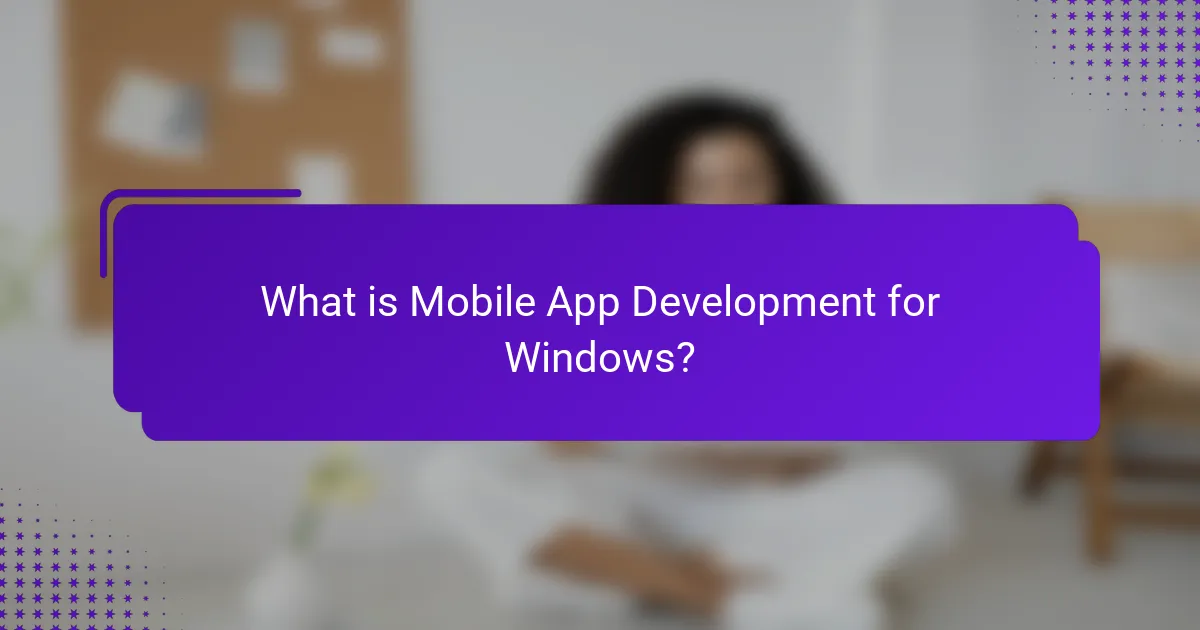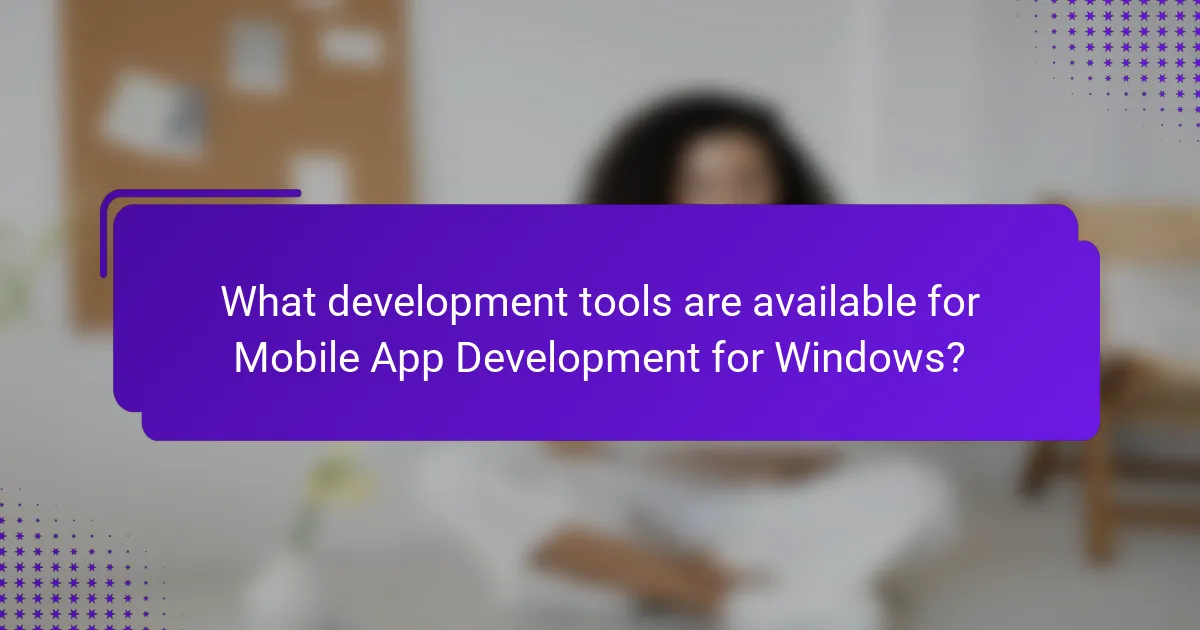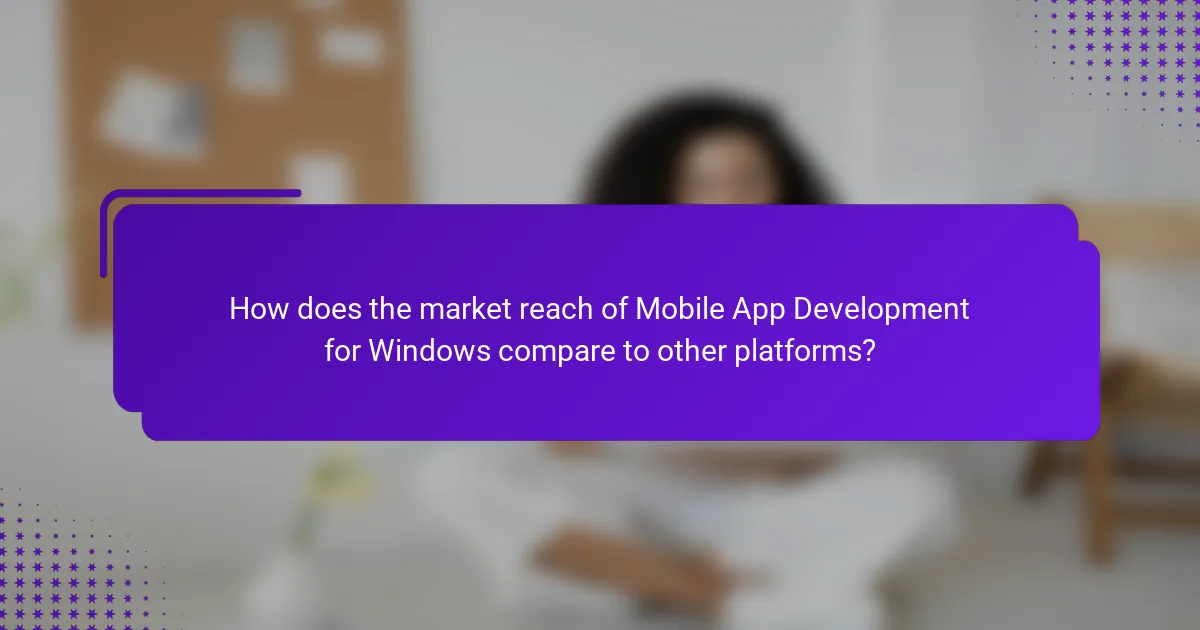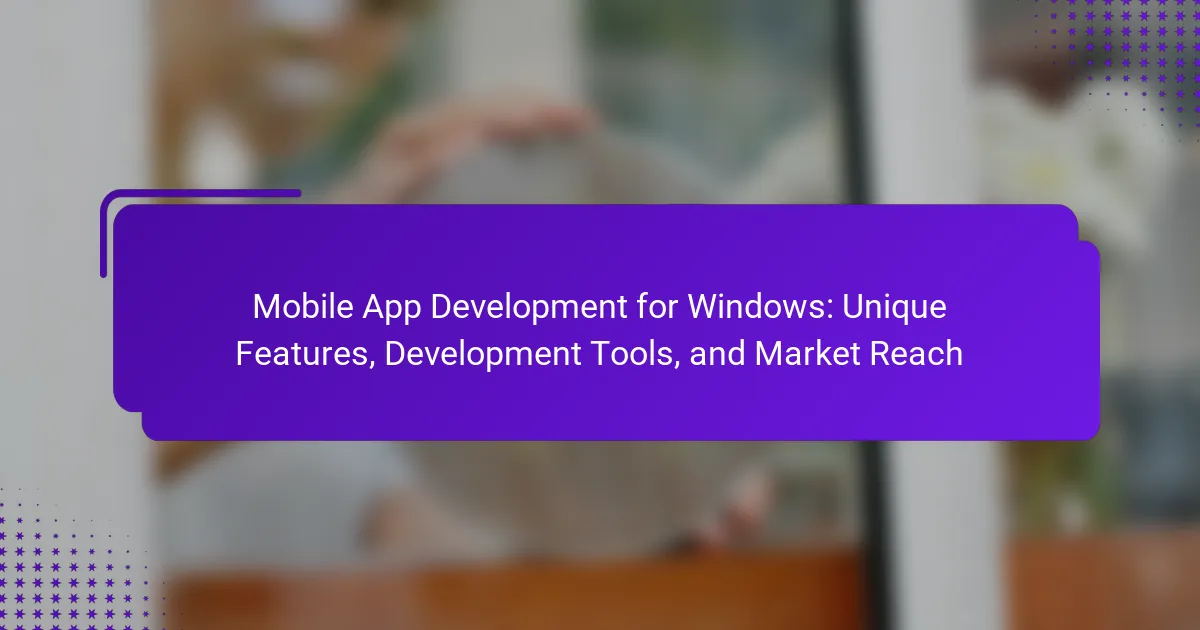Mobile app development for Windows involves creating software applications that operate on the Windows operating system, targeting devices such as PCs, tablets, and smartphones. Key development tools include Microsoft Visual Studio, which supports languages like C# and XAML, and enables the creation of Universal Windows Platform (UWP) apps that function across all Windows 10 devices. The article discusses the development process, including user interface design, coding, and testing, as well as the significance of tools like Xamarin and Windows App SDK. Additionally, it highlights the market challenges faced by Windows mobile app development, noting its limited market share compared to Android and iOS, which influences the focus of developers and the variety of available applications.

What is Mobile App Development for Windows?
Mobile app development for Windows refers to the process of creating software applications that run on the Windows operating system. This development can target various devices, including PCs, tablets, and smartphones. Windows app development typically utilizes tools like Microsoft Visual Studio and programming languages such as C# and XAML. Developers can create Universal Windows Platform (UWP) apps that are compatible across all Windows 10 devices. The process often involves designing user interfaces, coding functionality, and testing for performance and compatibility. According to Microsoft, UWP apps can leverage features like live tiles and notifications, enhancing user engagement.
How does Mobile App Development for Windows differ from other platforms?
Mobile app development for Windows differs from other platforms primarily due to its integration with the Windows operating system and its specific development tools. Windows apps often utilize Universal Windows Platform (UWP) which allows for a single app to run across multiple Windows devices. This contrasts with iOS and Android, which use their own respective frameworks and languages. Windows development heavily relies on Visual Studio as the primary IDE, while other platforms may use Xcode or Android Studio. Additionally, Windows apps often leverage .NET and C# for development, unlike the Java or Swift used in Android and iOS. The user interface design principles also differ, with Windows focusing more on adaptive layouts for various screen sizes. According to Microsoft, UWP apps can access a wider range of device capabilities, enhancing functionality.
What are the key characteristics of Windows mobile apps?
Windows mobile apps are characterized by their integration with the Windows ecosystem. They utilize a common codebase that allows for cross-platform compatibility. These apps support touch and gesture-based interactions, enhancing user experience. Windows mobile apps also leverage the Universal Windows Platform (UWP) for broader reach across devices. They can access native device features like camera and GPS. Windows mobile apps are designed with responsive layouts to adapt to various screen sizes. They often utilize live tiles for dynamic content updates on the home screen. Security features are built-in, ensuring user data protection.
How do user expectations influence Windows app development?
User expectations significantly influence Windows app development by shaping design and functionality requirements. Developers prioritize user feedback to create intuitive interfaces. This feedback often highlights desired features and performance standards. High user expectations lead to rigorous testing and quality assurance. For instance, Microsoft’s user experience guidelines emphasize responsiveness and accessibility. Meeting these expectations can enhance user satisfaction and retention. Research indicates that 70% of users abandon apps due to poor performance. Therefore, aligning development with user expectations is crucial for success in the Windows app market.
What unique features are associated with Mobile App Development for Windows?
Mobile App Development for Windows has unique features such as integration with Microsoft services. This includes seamless access to Azure cloud services. Developers can utilize the Universal Windows Platform (UWP) for cross-device compatibility. UWP allows apps to run on various Windows devices, including PCs and tablets. Windows apps support live tiles for real-time updates on the Start menu. They also offer a distinctive user interface tailored for touch and mouse input. Windows development leverages Visual Studio for a comprehensive development environment. Additionally, apps can utilize Windows-specific APIs for enhanced functionalities.
What are the advantages of developing apps specifically for Windows?
Developing apps specifically for Windows offers several advantages. Windows has a large user base, which provides access to millions of potential users. The Windows operating system is widely used in enterprise environments, making it ideal for business applications. Developers can leverage the integration with Microsoft services, enhancing functionality and user experience. Windows supports a variety of programming languages, allowing flexibility in development. The platform also offers robust development tools like Visual Studio, streamlining the app creation process. Furthermore, Windows provides strong security features, which are crucial for user trust and data protection. Overall, developing for Windows can lead to higher visibility and potential revenue due to its extensive market reach.
How do Windows operating system capabilities enhance app functionality?
Windows operating system capabilities enhance app functionality through a range of features. These include a robust API ecosystem that allows developers to integrate system-level functionalities. The integration of DirectX enables high-performance graphics for gaming and multimedia applications. Windows also supports a variety of programming languages, facilitating diverse app development. Additionally, its multitasking capabilities allow multiple applications to run simultaneously without performance degradation. The Windows Store provides a centralized platform for distribution and updates, enhancing user accessibility. Furthermore, security features like Windows Defender ensure safe app execution, fostering user trust. These capabilities collectively create an environment where applications can perform efficiently and securely.

What development tools are available for Mobile App Development for Windows?
Visual Studio is a primary development tool for mobile app development on Windows. It supports multiple programming languages, including C# and C++. Visual Studio offers a comprehensive integrated development environment (IDE). It provides features like debugging, code editing, and performance profiling. Xamarin is another significant tool that enables cross-platform mobile app development. It allows developers to use C# to create apps for both Android and iOS. Additionally, Windows App SDK facilitates building Windows apps using familiar frameworks. These tools are widely recognized and utilized in the industry for their robust features and support.
Which programming languages are commonly used in Windows app development?
C# and C++ are commonly used programming languages in Windows app development. C# is favored for its integration with the .NET framework, making it suitable for creating desktop applications. C++ is used for performance-critical applications and system-level programming. Additionally, JavaScript is utilized in conjunction with HTML and CSS for Universal Windows Platform (UWP) apps. Python is also gaining traction for its simplicity and versatility in scripting. These languages provide developers with various tools and frameworks to create efficient Windows applications.
What role does .NET play in Windows app development?
.NET is a framework that plays a crucial role in Windows app development. It provides a comprehensive environment for building applications across various Windows platforms. Developers utilize .NET to create desktop applications, web applications, and services. The framework supports multiple programming languages, including C# and VB.NET. This versatility allows developers to choose their preferred language while leveraging the same underlying libraries and tools. .NET also includes a rich set of libraries and APIs, which streamline the development process. The framework enhances performance and security for Windows applications. Additionally, .NET integrates with Visual Studio, a popular IDE, facilitating a smoother development experience. Overall, .NET is foundational for creating robust and efficient Windows applications.
How do Visual Studio and other IDEs facilitate development?
Visual Studio and other IDEs facilitate development by providing integrated tools that streamline coding, debugging, and testing processes. These environments offer features such as syntax highlighting, code completion, and error detection, which enhance productivity. Visual Studio includes a powerful debugger that allows developers to identify and fix issues in real-time. IDEs support version control systems, making collaboration easier among team members. They also provide templates and wizards that simplify project setup and configuration. Additionally, integrated documentation and community support provide resources for problem-solving and learning. These features collectively reduce development time and improve code quality, making the development process more efficient.
What frameworks support Mobile App Development for Windows?
Frameworks that support mobile app development for Windows include Xamarin, UWP (Universal Windows Platform), and React Native. Xamarin allows developers to create cross-platform apps using C#. UWP enables the development of applications that run across all Windows devices. React Native facilitates building mobile apps using JavaScript and React. Each framework provides unique advantages for Windows app development, like native performance and access to device features.
How does UWP (Universal Windows Platform) impact app development?
UWP (Universal Windows Platform) significantly impacts app development by providing a unified platform for building applications across various Windows devices. It enables developers to create apps that can run on PCs, tablets, Xbox, and IoT devices using a single codebase. This reduces development time and costs, as the same application can be deployed across multiple device types without extensive modifications. UWP also offers access to modern APIs and features such as adaptive user interfaces, which enhance the user experience across different screen sizes. Furthermore, UWP apps are distributed through the Microsoft Store, providing a centralized marketplace for users and developers. This integration allows for easier updates and better security for applications. Overall, UWP streamlines the development process while expanding the potential user base for applications.
What are the benefits of using Xamarin for cross-platform development?
Xamarin offers several benefits for cross-platform development. It allows developers to write code in C# and share it across multiple platforms, including iOS and Android. This significantly reduces development time and costs. Xamarin provides access to native APIs, enabling high-performance applications that feel native to each platform. The framework supports a single codebase, which simplifies maintenance and updates. Furthermore, Xamarin integrates seamlessly with Visual Studio, providing robust development tools and a familiar environment for developers. According to a report by Stack Overflow, C# is one of the most popular programming languages, which indicates a strong community and support for Xamarin.

How does the market reach of Mobile App Development for Windows compare to other platforms?
The market reach of mobile app development for Windows is significantly smaller compared to other platforms like iOS and Android. As of 2023, Windows holds approximately 2.5% of the global mobile operating system market share. In contrast, Android dominates with around 72% and iOS follows with about 27%. The limited reach is attributed to fewer devices running Windows Mobile and a decline in its popularity. Additionally, major app developers prioritize iOS and Android due to their larger user bases. This disparity in market share influences investment and development focus, leading to a wider array of apps on competing platforms.
What is the current market share of Windows mobile apps?
The current market share of Windows mobile apps is approximately 1% as of 2023. This figure reflects the overall decline in the Windows Phone operating system, which has significantly impacted app development for this platform. According to recent statistics, Android and iOS dominate the mobile app market, holding over 98% combined share. The limited adoption of Windows mobile devices contributes to the low market share of its apps. Additionally, major developers have shifted focus to more popular platforms, further decreasing the viability of Windows mobile apps.
How do user demographics affect the success of Windows apps?
User demographics significantly influence the success of Windows apps. Different age groups have varying preferences for app functionality and design. For instance, younger users often prefer apps with modern, sleek interfaces. In contrast, older demographics may favor simplicity and ease of use.
Income levels also play a crucial role. Higher-income users may be more willing to pay for premium apps, while lower-income users often seek free alternatives. Geographic location impacts app success as well. Users in urban areas may demand different features compared to those in rural regions.
Moreover, educational background affects how users interact with technology. More educated users might expect advanced features and customization options. According to a report by Statista, 30% of Windows app users are aged 18-24, indicating a significant market segment that developers should target with specific features.
Understanding these demographic factors helps developers create tailored experiences, ultimately leading to higher user satisfaction and app success.
What trends are shaping the future of Windows mobile app usage?
The future of Windows mobile app usage is being shaped by several key trends. One major trend is the integration of artificial intelligence into applications. AI enhances user experience through personalized recommendations and smarter functionalities. Another trend is the growing emphasis on cross-platform compatibility. Developers aim to create apps that function seamlessly across various operating systems.
Cloud-based applications are also gaining traction. They allow users to access apps and data from any device with internet connectivity. Additionally, there is an increasing focus on user privacy and security. This is driven by regulatory changes and user demand for data protection.
The rise of progressive web apps (PWAs) is notable as well. PWAs offer a hybrid experience, combining the best of web and mobile apps. Finally, the adoption of 5G technology is set to enhance app performance. Faster connectivity will enable more complex functionalities and real-time interactions. These trends collectively indicate a dynamic evolution in Windows mobile app usage.
What strategies can developers employ to enhance market reach?
Developers can enhance market reach by utilizing targeted marketing strategies. They should identify their target audience through market research. Understanding user demographics helps in tailoring marketing efforts. Developers can leverage social media platforms to promote their apps effectively. Engaging content and regular updates can attract more users. Collaborations with influencers can expand visibility. Offering promotions or discounts can incentivize downloads. Additionally, optimizing app store listings improves discoverability. These strategies have been shown to increase user acquisition and retention significantly.
How can developers optimize Windows apps for better visibility in the market?
Developers can optimize Windows apps for better visibility in the market by implementing effective app store optimization (ASO) strategies. These strategies include using relevant keywords in the app title and description. Incorporating high-quality visuals, such as screenshots and videos, can enhance user engagement. Regular updates and bug fixes improve user experience and retention rates. Encouraging user reviews and ratings boosts credibility and visibility. Promoting the app through social media and content marketing increases reach. Additionally, leveraging analytics tools can help developers understand user behavior and preferences. According to a report by Statista, apps with optimized ASO can see a significant increase in downloads, highlighting the importance of these strategies.
What marketing techniques are most effective for promoting Windows apps?
Effective marketing techniques for promoting Windows apps include search engine optimization (SEO) and social media marketing. SEO enhances app visibility on search engines, driving organic traffic. Research shows that 70% of users prefer organic search results. Social media marketing leverages platforms like Facebook and Twitter to engage potential users. Engaging content can increase shares and app awareness significantly. Additionally, influencer marketing can reach niche audiences effectively. Collaborating with influencers can boost credibility and user interest. Email marketing also remains a powerful tool, with a 3800% return on investment reported for effective campaigns. These techniques collectively enhance visibility and user acquisition for Windows apps.
What are the best practices for successful Mobile App Development for Windows?
Successful mobile app development for Windows requires a clear understanding of the platform’s unique features. Developers should utilize the Universal Windows Platform (UWP) to create apps that run across devices. Adhering to Microsoft’s design guidelines ensures a consistent user experience.
Incorporating responsive design is crucial for optimizing the app for various screen sizes. Regular testing on multiple Windows devices helps identify performance issues early. Leveraging Visual Studio as the primary development tool streamlines the coding process.
Utilizing APIs effectively enhances app functionality and integration with Windows features. Implementing user feedback loops improves app usability and satisfaction over time. Adopting agile development practices allows for iterative improvements and quick adaptations to market demands.
Mobile app development for Windows encompasses the creation of applications designed to operate on the Windows operating system across various devices, including PCs, tablets, and smartphones. The article explores key aspects such as the unique features of Windows mobile apps, the development tools available, including Visual Studio and Xamarin, and the impact of user expectations on app design and functionality. It also examines the current market reach of Windows apps compared to other platforms, highlighting the trends shaping their future and strategies for enhancing visibility and user acquisition. Overall, the content provides a comprehensive overview of the Windows app development landscape, focusing on essential tools, characteristics, and market dynamics.
